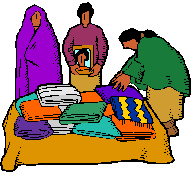History 3010 American Indian History

Texts:
First Peoples by Colin Calloway
Facing East from Indian Country by Daniel Richter
American Indians and the Law by N. Bruce Duthu
additional readings as assigned
Grades:
Grades will be based on a percentage of the points possible
A = 94 -100%
B = 83 - 86%
C = 73 - 76%
D = 60 - 66%
K.L. MacKay kmackay@weber.edu, ext. 6782
The purpose of this course is to provide an overview of American Indian history from pre-colonial times until the present. Emphasis is placed on Indian-Anglo cultural interaction, U.S. policy development, and the roles played by Indian peoples to ensure their survival and on-going cultural integrity into the 21st century.
Students have a responsibility to one another and to one another’s education. In this class, you and your classmates will generate knowledge through discussion and deliberation. In order for the class to be successful, you must be an active participant in both teaching and learning. In class, each of you will participate by discussing, deliberating, and analyzing the material. Outside of class, each of you will participate by reading the material and preparing assignments carefully. My role in the class is to create an environment that helps you construct knowledge. I will provide a course structure as well as ongoing guidance that will help you build your own knowledge
Learning Objectives:
- Historical Knowledge: students
will be able to:
- Describe the significant people, places and events of American Indian history.
- Analyze the historical forces that shaped the pre-contact traditions of the indigenous societies in North America.
- Explain the impact of disease, violence, and trade upon Indian people during the colonial period.
- Differentiate the major objectives, campaigns and outcomes of America’s Indian Wars.
- Describe the strategies of resistance and accommodation employed by Indian leaders facing forced removal.
- Give examples of Indian responses to their concentration on reservations by the federal government.
- Analyze the factors shaping federal Indian policy from allotment to reorganization.
- Describe the influence of red power on the politics of self-determination during the late twentieth century.
- Outline the major cases and laws affecting Indian County.
- Historical Thinking: Students
will be able to
- Evaluate the strengths, weaknesses, and trends in the historiography of American Indians.
- Historical Skills: Students will be able to:
- Critically discuss assigned texts
- Present in oral and written formats their research/analyses
Activities in support of Learning:
- Discussions, free-writes, field trips
- 5 response papers. 15 points each. Grading rubric
- 4 formal oral presentations. 10 points each. Evaluation criteria
- 2 Exams -- short essay. 50 points each
- Book review. Students will read a contemporary novel by an American Indian author and will orally present their responses to the text to the class. 20 points.
Participation:
Participation--in class discussions, in the service project, etc. is highly valued in this class. Students will assess their participation in a short paper. 20 points.